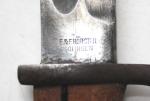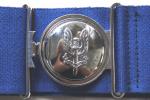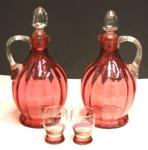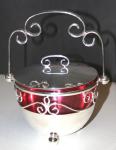-
Posts
13,225 -
Joined
-
Last visited
-
Days Won
22
Content Type
Profiles
Forums
Blogs
Gallery
Events
Store
Everything posted by Mervyn Mitton
-
-
-
I know Chris brought the other one back to the top in order to circulate the number after it was stolen in the post. This being so, I would not normally have put this one -on. However, it is by a different maker - and, has no issue numbers at all. Perhaps it was taken from stores before issue - does anyone have any other reasons ? Covered in thick grease - which has preserved it for nearly 100 years - but the devil to get off - took ages. The bayonet has the date 1913 on the spine .
-
-
-
This is a common bayonet - it is derived from the European FN Rifle bayonet. However, the difference is that it is made in South Africa and was for the R1 service rifle - which in turn was copied from the FN. You will see on the grip that there is a large 'U' - this is the mark for Sth. African weapons. There was a further version of the R1 - the R5 which was smaller - I am not familiar with all of the modern SA weapons - so, if I am wrong please correct me. The markings have been over stamped - I can't quite work them out.
-
Odin - you have done a fantastic job with this 100th year photograph - very professional. Did the photo have a 'key' - I am curious about how you identified each person ? The people who are shown as Chief Constables - do you know if they were from adjoining Forces ? I am aware that the title of Chief Constable has been used on a few occasions within the Met. - but, to my knowledge the rank was earlier and not a very senior one. This is a large number of the most senior officers for the main British Police Force - and taken to mark the first Centenary. I, personally, think that enquiries should be made with the Metropolitan Police Museum to ensure that they have this photo and the identifications on file. Should this not be the case , then I think - with your permission - that our Chairman should have a copy made and presented from GMIC. I was interested to see that the Chief of the Special Constables was given such a prominent position - and the other man you point out as his possible deputy, is wearing a similar uniform. Just a personal observation - the five CO supts. all look a bit shifty - must be the light........... Thankyou for taking the trouble to make this post possible - I can assure you that it has been a valuable exercise. Mervyn
-

CRANBERRY GLASS
Mervyn Mitton replied to Mervyn Mitton's topic in Non Military Collectibles & Antiques
This picture clearly shows the Pontil - the area where the glass blower's rod had the blob of glass attached. This will always be left neat and tidy on a good item. -

CRANBERRY GLASS
Mervyn Mitton replied to Mervyn Mitton's topic in Non Military Collectibles & Antiques
This view shows how the handle and the stopper were left as plain glass - this was to accentuate the Cranberry glass. The detail work on where the handle is fixed to the decanter is superb. -

CRANBERRY GLASS
Mervyn Mitton replied to Mervyn Mitton's topic in Non Military Collectibles & Antiques
This is a lovely matching pair of small decanters - approx. 11inches tall (27cm). They have a pair of small cranberry glasses with them and were probably intended for holding a liquour. They date from around the 1870's and as a pair are quite rare. -

CRANBERRY GLASS
Mervyn Mitton replied to Mervyn Mitton's topic in Non Military Collectibles & Antiques
This view shows the Cranberry glass inner container. It is domed underneath - so, has to be in a stand http://gmic.co.uk/uploads/monthly_08_2011/post-6209-0-76493400-1312465714.jpg. -
This is the reddish glass that you often see in antique shops - very often in beautiful shapes and colours. Not a modern discovery - the Romans had a means to make a red glass - however, the secret was lost hundreds of year's ago. An Italian - Antonio Neni is credited with re-discovering the process in 1612 when he added some gold to molten glass. Needless to say - there is some arguement on whether he was the first ? To create Ruby or, Cranberry glass is technically very difficult and can involve whole teams of people - make a mistake and you have an expensive sludge. Basically, gold chloride in various strengths and combinations are added to the glass - and this gives the lovely red richness to the glass. The 19th Century was particularly popular for Cranberry - the Victorians used it in many different forms , from table centrepieces to small vases and jewel boxes. For some reason it was very popular in Canada and a factory was established there. Pieces from this source tend not to be so collectable. There was also a revival of interest in the 1920's and this has continued. Later pieces are not necessarily less desired or a great deal cheaper - but it would be true to say that quality Victorian items have preference. Cranberry glass is usually moulded or, handblown. When this last method is used you will see on the base the area where it has been broken off from the blowing rod. This should have been filed down. This roughened area is called the PONTIL. I will show one or, two examples and please feel free to post photos and ask questions of our Panel. This first piece dates from about 1900/1910 and was intended as a sugar bowl. Nowdays, it would be used for many other purposes - including holding cream , sweets etc..
-
Actually - all jokes aside - this is a very good example and has been gilded as well. The Mahouts usually have the job handed down Father to Son and these goads are essential to work the elephant. Genuine ones - as this one - are fairly rare on the market. I have one from Thailand I will have photgraphed. Meanwhile, thankyou Brian - I don't think the thread will have too many replies though - still, we might be surprised.
-
Excellent Tim - thankyou. Guardforce - with that colour scheme would seem very likely. I'll try to get confirmation. Don't know why I didn't pick-up on the Intelligence Corps - badge was a bit shiny and I didn't check further. The Intel. Corps badge is one of the rarest for UDI period and is expensive - this makes the belt just as good - so thankyou again !
-
I agree with Nick - until Brian started calling it the Custodian it was not a name I was familiar with. I assumed it was a later issue from my old type. From when the top hats were discontinued the Met. pattern was always called the Bell type Police Helmet. I think this - from what Nick has said - still holds true. Craig's expression of 'lid' still also, holds - we called them that - but, usually, just referred to them as a helmet. For his other name - I can only say he is in South London - we were much 'posher' in the East End !





















